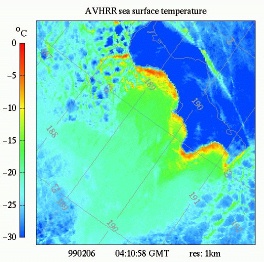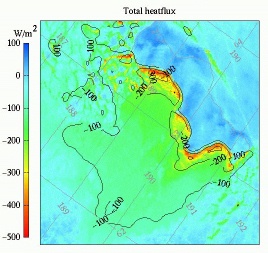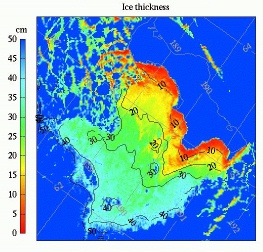Using the infrared radiometry from channels 4 and 5 of the Advanced Very High Resolution Radiometer (AVHRR) aboard the National Oceanic and Atmospheric Administration's NOAA-12 satellite, we can calculate estimates of the sea surface temperature (SST) using the Key-Haefliger algorithm:

|
SST = A + B*Tb4 + C*(Tb4-Tb5) + D*(Tb4-Tb5)*(sec(Z)-1)
where Tb4 and Tb5 are the channel 4 and 5 brightness temperatures,
Z is the satellite zenith angle, and coefficients A,B,C and D are the
Arctic snow-ice coefficients for the appropriate temperature range and
satellite.
|
Knowledge of the sea surface temperature, along with the surface air temperature (SAT), the sea level pressure (SLP), and the surface wind speed (Ws), allows us to calculate an estimate of the heatflux, Ft:

|
Ft = Fs + Fl + Fe + Fb + Fr
where:
Fs = sensible heat flux
Fl = latent heat flux
Fe = emitted LW radiation (from surface)
Fb = back (incoming) LW radiation (from clouds)
Fr = Incoming shortwave radiation
|
For the heatflux calculation we use SATs from the POLES dataset, and SLPs from the NCEP/NCAR reanalysis. Surface windspeed is estimated from calculated geostrophic wind. We assume thin ice surface conditions, and we assume a clear sky (cloud fraction 0) whenever we have a clear AVHRR image.
Finally, from Ft we can estimate the ice thickness H:

|
H = ki*(Ft - Ti)
where
ki = 2.034 is the thermal conductivity of sea ice
Ti = -1.8 is the freezing point of seawater.
|
References:
Key, J. and Haefliger, M., Arctic Ice Surface Temperature Retrieval from AVHHR Thermal Channels, JGR Vol. 97, No. D5, pp 5885-5893, April 20, 1992
Efimova,N.A., On methods of calculating monthly values of long-
wave radiation, Meteorol. Gidrol.,10, pp.28-33,1961
Jacobs,J.D., Radiation climate of Broughton Island, Energy budget
studies in relation to fast-ice breakup processes in Davis Strait,
Occas.Pap.26, pp.105-120, Inst. of Arctic and Alp. Res., Univ. of
Colorado, Boulder,1978
Key, J. R., Silcox, R. A. and R. S. Stone, Evaluation of surface
radiative flux parameterizations for us in the sea ice models, J.
Geophys. Res., 101, 3839-3849, 1996. (contains the radiation models.)
List,R.J., Smithsonian Meteorological Tables, 6th rev. ed., 527 pp.,
Smithsonian Institution Press, Washington,D.C.,1984
Maykut, G. A., Energy exchange over young sea ice in the Central Arctic,
J. Geophys. Res., 83, 3646-3658, 1978.
Maykut, G. A., The surface heat and mass balance, in The Geophysics of
Sea Ice, N. Untersteiner, ed., Plenum Press, New York (NATO ASI series,
Series B, Physics; 146), 395-463, 1196 pages, 1986. (contains the over
ice sensible and evaporative coefficients.)
Shine,K.P., Parameterization of shortwave flux over high albedo surfaces
as a function of cloud thickness and surface albedo, Q.J.R. Meteorol.Soc.,
110, pp.747-764, 1984
Shine,K.P. and A. Henderson-Sellers, The sensitivity of a thermodynamic
sea ice model to changes in surface albedo parameterization, J.Geophys.
Res.,90, pp.2243-2250, 1985
Smith, S. D., Coefficients for sea surface wind stress, heat flux, and
wind profiles as a function of wind speed and temperature, J. Geophys.
Res., 93, 15,467-15,472, 1988. (contains the look-up table, and the
sensible and evaporative coefficients for open water.)
Acknowledgements:
We are indebted to Kevin Engle of the University of Alaska's Alaska SAR Facility for providing us with the AVHRR data for this study, as well as to the National Oceanographic and Atmospheric Administration (NOAA)
Back to St Lawrence Polynya page


